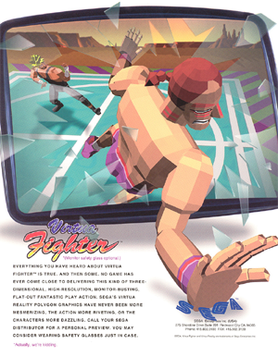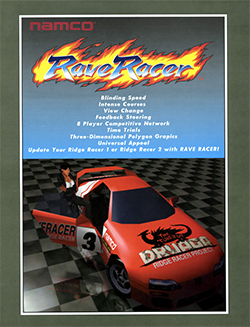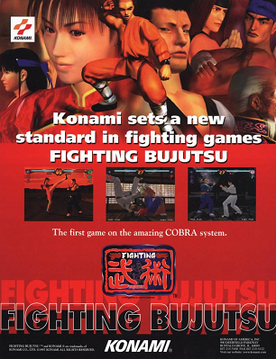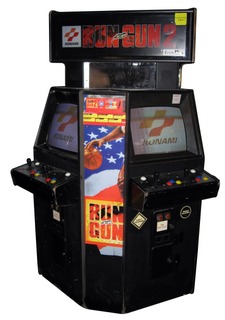
Puzzle Bobble, internationally known as Bust-A-Move, is a 1994 tile-matching puzzle arcade game developed and published by Taito. It is based on the 1986 arcade game Bubble Bobble, featuring characters and themes from that game. Its characteristically cute Japanese animation and music, along with its play mechanics and level designs, made it successful as an arcade title and spawned several sequels and ports to home gaming systems.

Virtua Fighter is a fighting game created for the Sega Model 1 arcade platform by AM2, a development group within Sega, headed by Yu Suzuki. An early prototype version was location tested in Japan by August 1993, before the complete game was released worldwide in December 1993. It was the first arcade fighting game to feature fully 3D polygon graphics. The game was ported to Sega Saturn as a global launch title in 1994 and 1995, and also received a port to the Sega 32X.

Ikari Warriors, known as Ikari in Japan, is a vertically scrolling run and gun video game released for arcades by SNK in 1986. It was published in North America by Tradewest. At the time there were many Commando clones on the market. What distinguished Ikari Warriors were rotary joysticks and a two-player cooperative mode. The rotary joystick controls were in turn based on SNK's earlier TNK III (1985). Ikari was originally intended to be an official licensed adaptation of the film Rambo: First Blood Part II (1985), but SNK were initially unable to acquire the rights to the film.

Magical Drop, sometimes referred to in Japanese as MagiDro (マジドロ), is a series of puzzle games first released in the arcade, and later primarily for several platforms such as the Neo Geo Arcade, Super Famicom, Sega Saturn, PlayStation, Bandai WonderSwan, GBC and the Neo Geo Pocket Color; most of which were published by Data East.

Rave Racer is a 1995 arcade racing video game from Namco. It is the third title in the Ridge Racer series and the follow-up to Ridge Racer and Ridge Racer 2. Rave Racer runs on Namco System 22 hardware, and could be played by two people per cabinet for up to eight players total when up to four of them were linked together. Compared to Ridge Racer 2, Rave Racer adds two new tracks as well as the ability to play the original two, various handling changes, force feedback steering, and improved car and racetrack graphics. Rave Racer was a critical and commercial success; it would be the last major arcade Ridge Racer title as Namco would continue the series on home consoles with Rage Racer (1996) and R4: Ridge Racer Type 4 (1998).

Puzzle Bobble 2 is a tile-matching video game by Taito. The first sequel to Puzzle Bobble, it is also known in Europe and North America as Bust-A-Move Again for arcades and Bust-A-Move 2: Arcade Edition for home consoles. Released into the arcades in 1995, home conversions followed for the PlayStation, Sega Saturn, Nintendo 64, and Windows platforms. The game was included in Taito Legends 2, but the US arcade version was included in the US PS2 version instead. Further ports for the Nintendo Switch, PlayStation 4, and Xbox One were released by City Connection alongside Puzzle Bobble 3 in February 2023.

Virtua Fighter 3 is a 1996 fighting game developed and published by Sega, the sequel to 1994's Virtua Fighter 2 as part of the Virtua Fighter series. Released originally on arcades, an updated version named Virtua Fighter 3tb was later made with the addition of team battles. This updated version of the game was ported to the Dreamcast home console in 1998 after the cancellation of a Sega Saturn port.

WWF WrestleFest is a professional wrestling video game developed and released by Technōs Japan for arcades in 1991, featuring stars of the World Wrestling Federation (WWF). The game was distributed by Technōs in Japan and North America, and by Tecmo in Japan, Europe and Australasia. It is the sequel to Technōs' previous WWF game, WWF Superstars. Compared to Superstars, WrestleFest adds a variety of different wrestlers to the roster as well as enhanced graphics and sound. There are more voice samples, including commentary and pre-match introductions by WWF ring announcer Mike McGuirk. The voiced cut scenes featuring Gene Okerlund from Superstars returned as well.

Ace Driver is a 1994 racing arcade game developed and published by Namco. The player controls a Formula One racer, with the objective being to complete three laps of a race course and to avoid a collision with opponents and other obstacles. Three difficulty levels are available, as is a mode to enable a gear shift. Similar to Namco's own Final Lap series, the arcade cabinet can be linked together with another unit to enable eight-person multiplayer. It ran on the Namco System 22 arcade hardware.

Alpine Racer is a racing sports video game developed and published by Namco for arcades. It had a limited release in December 1994, followed by a wide release in July 1995. It ran on the Namco System 22 arcade hardware.

Street Slam is a basketball video game developed by Data East for Neo Geo, released in 1994. The game features three-on-three basketball match-ups with a variety of different teams. Street Slam is the only basketball game released on the Neo Geo.

Cyber Sled is a vehicular combat video game developed and published by Namco. It was originally released for arcades in 1993. The game's perspective is third-person by default, but can be switched to a first-person perspective. The game was nominated for Most Innovative New Technology at the 1994 AMOA Awards. It later received a sequel in 1994, Cyber Commando.

Fighting Bujutsu, known in Japan as Fighting Wu-Shu, is a 1997 3D fighting arcade game developed and published by Konami, released on their Konami Cobra arcade board. It is Konami's second attempt in the 3D fighting game market, after their Lightning Legend: Daigo no Daibouken in 1996.

Super Major League is a baseball sports video game developed and published by Sega for arcades in 1995. It is a successor to Sega's 1985 arcade baseball game Major League.

Run and Gun II is a basketball video game developed and published by Konami as an arcade video game in 1996.















